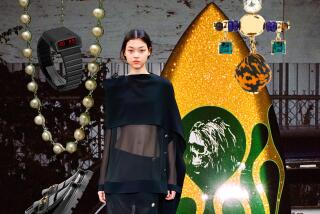Bye-bye to bling: Men are wearing less jewelry, and keeping it understated
- Share via
If we are to take our cues from GQ magazine, men are no longer rushing for gold — no diamonds, no elaborate chains or any other flashy jewelry.
May cover model Jake Gyllenhaal’s sole hint of bling is an understated $15 silver tie bar. Looking inside the issue’s 162 pages, we find exactly four editorial subjects wearing jewelry beyond wedding rings or watches: a thin chain link bracelet on Lou Dobbs, a David Yurman dog tag and wooden beads on San Francisco Giants pitcher Tim Lincecum, studs on L.A. Dodgers center fielder Matt Kemp and a class ring on Drums guitarist Jacob Graham.
As recently as two years ago, sales of men’s jewelry reached almost $6 billion. Joining the ranks of rockers and rappers, Hollywood’s leading men were flashing more ice than Liz Taylor. But — with the possible exception of the hardware adorning the cast of “Jersey Shore” — today’s trend in men’s jewelry is taking a quieter turn with simple, masculine pieces in leather, fabric and silver. Think more Tim McGraw, less P. Diddy.
“When it comes to men’s jewelry, I’m not crazy about bling-bling. If a guy’s really loaded down with jewelry, I think it looks sort of strange,” says Garth Condit, a fashion stylist who has worked with McGraw for the last nine years. “With Tim, I’ve pulled back on jewelry. He has a great mix of simple silver cuffs, thin silver chains, an interesting woven leather bracelet for guys from YSL. Some Cartier rings for concerts. In real life he mainly wears a necklace and his wedding ring.”
The music industry has typically lead the pack when it comes to men’s jewelry. If rockers and rappers set the stage for yesterday’s bling, today the men of country music are taking a more laid-back, masculine aesthetic, and their industry spokesmen are, not surprisingly, happy to chat about it. “Men in country music are incredibly stylish,” says Brooke Primero, senior director of publicity and marketing for the Academy of Country Music.
“Overall they look for accessories that don’t make too big a splash. They aren’t going for ‘statement’ pieces that jump out. It’s more about a great watch, strong belt buckle, a thick chain bracelet or leather cuff — but only one. It’s rare to see them rocking multiple accessories that would be bling, unless you’re talking performance wear,” Primero says.
“Bling is out,” concurs Darren Gold, co-owner of Alpha Gear for Gents in Los Angeles. “There was a moment when flashy, chunky sculls were in, but now it’s much more subtle. Bracelets are big — whether that’s leather or metal or a mix of the two.”
Alpha’s top sellers include Sami bracelets from Lapland, made from reindeer leather and woven pewter strands with a button carved from antlers. They can be stacked together or mixed with a simple silver cuff. The store also carries fabric bracelets with a retro Hermès vibe from former Dolce & Gabbana model and Los Angeles local Justin von der Fehr. Von der Fehr crafts his wrap bracelets from vintage striped silk, each piece hand-stitched and finished with lizard.
Nearby at Maxfield, one of L.A.’s longtime arbiters of chic, bracelets outsell rings 2-to-1, says General Manager Deirdre Wheaton.
“We sell a lot of heavier silver chain bracelets,” Wheaton says. “In this town, men like to have clean, masculine pieces.” In addition to modern silver bracelets and leather wrist wraps, Maxfield has a strong collection of tie clips and vintage stick pins in enamel and metal that make for a classic retro statement with a suit.
But ultimately the biggest trend in men’s accessories comes down to software, not hardware. Men’s jewelry sales in the U.S. have dipped 15% in the last year alone, according to the NPD Group, a consumer and retail market research company based in Port Washington, N.Y.
“Following a recession is generally a boom time for accessories,” says Marshal Cohen, chief retail analyst at the NPD Group. But “discretionary spending is shifting pretty dramatically, and interest in all these other industries like electronics and healthy living have captured the consumers’ attention and dollar. Today’s consumer says, ‘As long as I stay in touch with the trends, I don’t have to wear them. I just have to know about them.’ ”
Which means that a dude may be more likely to read GQ on his new iPad than shop from its pages.






